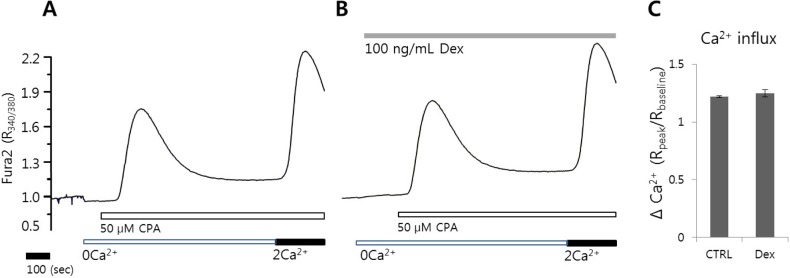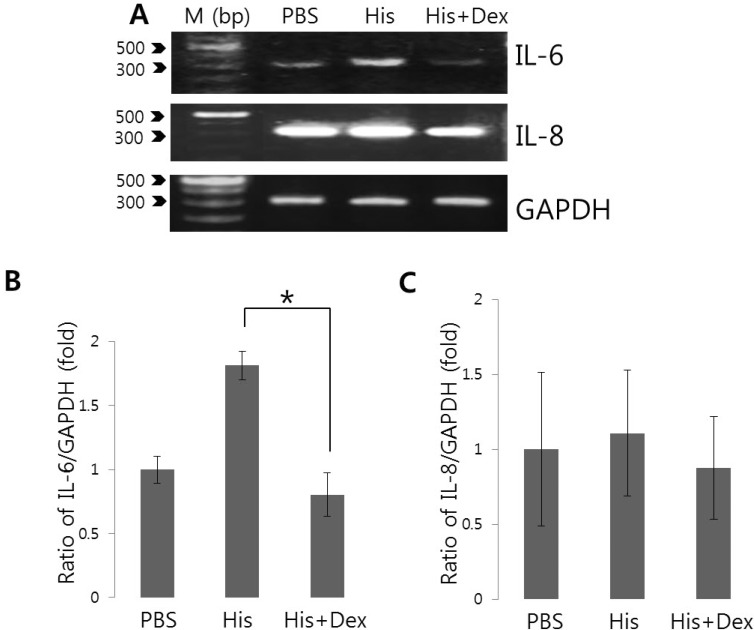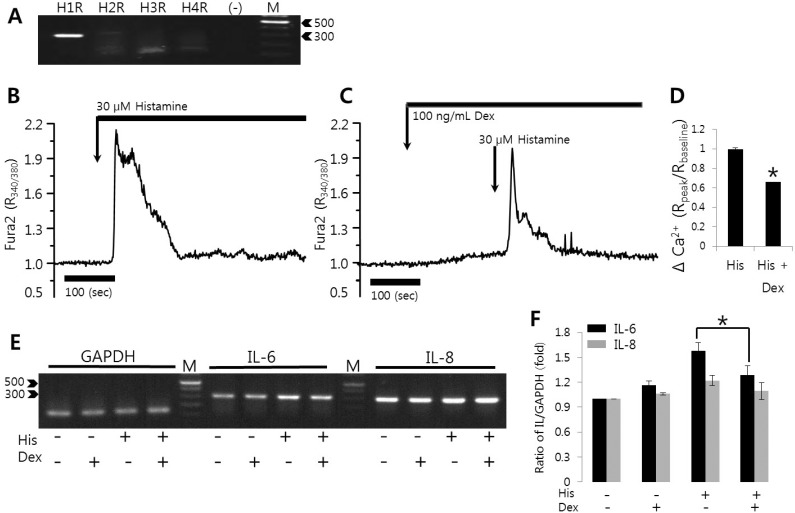Korean J Physiol Pharmacol.
2015 Sep;19(5):413-420. 10.4196/kjpp.2015.19.5.413.
Dexmedetomidine Modulates Histamine-induced Ca2+ Signaling and Pro-inflammatory Cytokine Expression
- Affiliations
-
- 1Department of Physiology, College of Medicine, Gachon University, Incheon 406-799, Korea. minicleo@gachon.ac.kr
- KMID: 2285585
- DOI: http://doi.org/10.4196/kjpp.2015.19.5.413
Abstract
- Dexmedetomidine is a sedative and analgesic agent that exerts its effects by selectively agonizing alpha2 adrenoceptor. Histamine is a pathophysiological amine that activates G protein-coupled receptors, to induce Ca2+ release and subsequent mediate or progress inflammation. Dexmedetomidine has been reported to exert inhibitory effect on inflammation both in vitro and in vivo studies. However, it is unclear that dexmedetomidine modulates histamine-induced signaling and pro-inflammatory cytokine expression. This study was carried out to assess how dexmedetomidine modulates histamine-induced Ca2+ signaling and regulates the expression of pro-inflammatory cytokine genes encoding interleukin (IL)-6 and -8. To elucidate the regulatory role of dexmedetomidine on histamine signaling, HeLa cells and human salivary gland cells which are endogenously expressed histamine 1 receptor were used. Dexmedetomidine itself did not trigger Ca2+ peak or increase in the presence or absence of external Ca2+. When cells were stimulated with histamine after pretreatment with various concentrations of dexmedetomidine, we observed inhibited histamine-induced [Ca2+]i signal in both cell types. Histamine stimulated IL-6 mRNA expression not IL-8 mRNA within 2 hrs, however this effect was attenuated by dexmedetomidine. Collectively, these findings suggest that dexmedetomidine modulates histamine-induced Ca2+ signaling and IL-6 expression and will be useful for understanding the antagonistic properties of dexmedetomidine on histamine-induced signaling beyond its sedative effect.
MeSH Terms
Figure
Reference
-
1. Kamibayashi T, Maze M. Clinical uses of alpha2-adrenergic agonists. Anesthesiology. 2000; 93:1345–1349. PMID: 11046225.2. Jackson KC 3rd, Wohlt P, Fine PG. Dexmedetomidine: a novel analgesic with palliative medicine potential. J Pain Palliat Care Pharmacother. 2006; 20:23–27. PMID: 16702133.3. Kocoglu H, Karaaslan K, Gonca E, Bozdogan O, Gulcu N. Preconditionin effects of dexmedetomidine on myocardial ischemia/reperfusion injury in rats. Curr Ther Res Clin Exp. 2008; 69:150–158. PMID: 24692794.
Article4. Hoffman WE, Kochs E, Werner C, Thomas C, Albrecht RF. Dexmedetomidine improves neurologic outcome from incomplete ischemia in the rat. Reversal by the alpha 2-adrenergic antagonist atipamezole. Anesthesiology. 1991; 75:328–332. PMID: 1677549.5. Okada H, Kurita T, Mochizuki T, Morita K, Sato S. The cardioprotective effect of dexmedetomidine on global ischaemia in isolated rat hearts. Resuscitation. 2007; 74:538–545. PMID: 17391832.
Article6. Si YN, Bao HG, Xu L, Wang XL, Shen Y, Wang JS, Yang XB. Dexmedetomidine protects against ischemia/reperfusion injury in rat kidney. Eur Rev Med Pharmacol Sci. 2014; 18:1843–1851. PMID: 25010612.7. Plambech MZ, Afshari A. Dexmedetomidine in the pediatric population: a review. Minerva Anestesiol. 2015; 81:320–332. PMID: 24824958.8. Zhang X, Wang J, Qian W, Zhao J, Sun L, Qian Y, Xiao H. Dexmedetomidine inhibits inducible nitric oxide synthase in lipopolysaccharide-stimulated microglia by suppression of extracellular signal-regulated kinase. Neurol Res. 2015; 37:238–245. PMID: 25082544.
Article9. Tanabe K, Matsushima-Nishiwaki R, Kozawa O, Iida H. Dexmedetomidine suppresses interleukin-1β-induced interleukin-6 synthesis in rat glial cells. Int J Mol Med. 2014; 34:1032–1038. PMID: 25069417.
Article10. Liao Z, Cao D, Han X, Liu C, Peng J, Zuo Z, Wang F, Li Y. Both JNK and P38 MAPK pathways participate in the protection by dexmedetomidine against isoflurane-induced neuroapoptosis in the hippocampus of neonatal rats. Brain Res Bull. 2014; 107:69–78. PMID: 25026397.
Article11. Zhang X, Wang J, Qian W, Zhao J, Sun L, Qian Y, Xiao H. Dexmedetomidine inhibits tumor necrosis factor-alpha and interleukin 6 in lipopolysaccharide-stimulated astrocytes by suppression of c-Jun N-terminal kinases. Inflammation. 2014; 37:942–949. PMID: 24429914.
Article12. Peng M, Wang YL, Wang CY, Chen C. Dexmedetomidine attenuates lipopolysaccharide-induced proinflammatory response in primary microglia. J Surg Res. 2013; 179:e219–e225. PMID: 22683080.
Article13. Zhao Z, Code WE, Hertz L. Dexmedetomidine, a potent and highly specific alpha 2 agonist, evokes cytosolic calcium surge in astrocytes but not in neurons. Neuropharmacology. 1992; 31:1077–1079. PMID: 1359438.14. Berridge MJ, Lipp P, Bootman MD. The versatility and universality of calcium signalling. Nat Rev Mol Cell Biol. 2000; 1:11–21. PMID: 11413485.
Article15. Berridge MJ, Bootman MD, Roderick HL. Calcium signalling: dynamics, homeostasis and remodelling. Nat Rev Mol Cell Biol. 2003; 4:517–529. PMID: 12838335.
Article16. Lim SA, Hwang KY, Chung SH. Niflumic acid reduces histamine-induced interleukin-6 and -8 expression in human conjunctival epithelial cells. Ophthalmic Res. 2013; 50:192–196. PMID: 24030317.
Article17. Dunford PJ, O'Donnell N, Riley JP, Williams KN, Karlsson L, Thurmond RL. The histamine H4 receptor mediates allergic airway inflammation by regulating the activation of CD4+ T cells. J Immunol. 2006; 176:7062–7070. PMID: 16709868.
Article18. Coruzzi G, Adami M, Guaita E, de Esch IJ, Leurs R. Antiinflammatory and antinociceptive effects of the selective histamine H4-receptor antagonists JNJ7777120 and VUF6002 in a rat model of carrageenan-induced acute inflammation. Eur J Pharmacol. 2007; 563:240–244. PMID: 17382315.
Article19. Mizuguchi H, Ono S, Hattori M, Sasaki Y, Fukui H. Usefulness of HeLa cells to evaluate inverse agonistic activity of antihistamines. Int Immunopharmacol. 2013; 15:539–543. PMID: 23453703.
Article20. Ok SH, Bae SI, Shim HS, Sohn JT. Dexmedetomidine-induced contraction of isolated rat aorta is dependent on extracellular calcium concentration. Korean J Anesthesiol. 2012; 63:253–259. PMID: 23060983.
Article21. Dewitt S, Laffafian I, Morris MR, Hallett MB. Cytosolic Ca2+ measurement and imaging in inflammatory cells. Methods Mol Biol. 2003; 225:47–59. PMID: 12769473.
Article22. Hong JH, Lee SI, Kim KE, Yong TS, Seo JT, Sohn MH, Shin DM. German cockroach extract activates protease-activated receptor 2 in human airway epithelial cells. J Allergy Clin Immunol. 2004; 113:315–319. PMID: 14767448.
Article23. Newton K, Dixit VM. Signaling in innate immunity and inflammation. Cold Spring Harb Perspect Biol. 2012; 4:pii: a006049.
Article24. Hoffmann A, Kann O, Ohlemeyer C, Hanisch UK, Kettenmann H. Elevation of basal intracellular calcium as a central element in the activation of brain macrophages (microglia): suppression of receptor-evoked calcium signaling and control of release function. J Neurosci. 2003; 23:4410–4419. PMID: 12805281.
Article25. Kim JH, Park SH, Moon YW, Hwang S, Kim D, Jo SH, Oh SB, Kim JS, Jahng JW, Lee JH, Lee SJ, Choi SY, Park K. Histamine H1 receptor induces cytosolic calcium increase and aquaporin translocation in human salivary gland cells. J Pharmacol Exp Ther. 2009; 330:403–412. PMID: 19443731.
Article26. Zhou MH, Zheng H, Si H, Jin Y, Peng JM, He L, Zhou Y, Muñoz-Garay C, Zawieja DC, Kuo L, Peng X, Zhang SL. Stromal interaction molecule 1 (STIM1) and Orai1 mediate histamine-evoked calcium entry and nuclear factor of activated T-cells (NFAT) signaling in human umbilical vein endothelial cells. J Biol Chem. 2014; 289:29446–29456. PMID: 25190815.
Article27. Repka-Ramirez MS, Baraniuk JN. Histamine in health and disease. Clin Allergy Immunol. 2002; 17:1–25. PMID: 12113214.28. Hill SJ, Ganellin CR, Timmerman H, Schwartz JC, Shankley NP, Young JM, Schunack W, Levi R, Haas HL. International Union of Pharmacology. XIII. Classification of histamine receptors. Pharmacol Rev. 1997; 49:253–278. PMID: 9311023.29. Oda T, Morikawa N, Saito Y, Masuho Y, Matsumoto S. Molecular cloning and characterization of a novel type of histamine receptor preferentially expressed in leukocytes. J Biol Chem. 2000; 275:36781–36786. PMID: 10973974.
Article30. Firth AL, Won JY, Park WS. Regulation of Ca2+ signaling in pulmonary hypertension. Korean J Physiol Pharmacol. 2013; 17:1–8. PMID: 23439762.31. Das AK, Yoshimura S, Mishima R, Fujimoto K, Mizuguchi H, Dev S, Wakayama Y, Kitamura Y, Horio S, Takeda N, Fukui H. Stimulation of histamine H1 receptor up-regulates histamine H1 receptor itself through activation of receptor gene transcription. J Pharmacol Sci. 2007; 103:374–382. PMID: 17409634.
Article32. Mizuguchi H, Terao T, Kitai M, Ikeda M, Yoshimura Y, Das AK, Kitamura Y, Takeda N, Fukui H. Involvement of protein kinase Cdelta/extracellular signal-regulated kinase/poly(ADP-ribose) polymerase-1 (PARP-1) signaling pathway in histamine-induced up-regulation of histamine H1 receptor gene expression in HeLa cells. J Biol Chem. 2011; 286:30542–30551. PMID: 21730054.33. Schmelz M, Schmidt R, Weidner C, Hilliges M, Torebjork HE, Handwerker HO. Chemical response pattern of different classes of C-nociceptors to pruritogens and algogens. J Neurophysiol. 2003; 89:2441–2448. PMID: 12611975.
Article34. Shim WS, Tak MH, Lee MH, Kim M, Kim M, Koo JY, Lee CH, Kim M, Oh U. TRPV1 mediates histamine-induced itching via the activation of phospholipase A2 and 12-lipoxygenase. J Neurosci. 2007; 27:2331–2337. PMID: 17329430.
Article35. Laidlaw A, Flecknell P, Rees JL. Production of acute and chronic itch with histamine and contact sensitizers in the mouse and guinea pig. Exp Dermatol. 2002; 11:285–291. PMID: 12190936.
Article36. Sisto M, Lisi S, Lofrumento DD, Cucci L, Mitolo V, D'Amore M. Blockade of TNF-α signaling suppresses the AREG-mediated IL-6 and IL-8 cytokines secretion induced by anti-Ro/SSA autoantibodies. Lab Invest. 2010; [Epub ahead of print].
Article37. Son GY, Shin DM, Hong JH. Bacterial PAMPs and Allergens Trigger Increase in [Ca2+]i-induced Cytokine Expression in Human PDL Fibroblasts. Korean J Physiol Pharmacol. 2015; 19:291–297. PMID: 25954136.38. Ebert TJ, Hall JE, Barney JA, Uhrich TD, Colinco MD. The effects of increasing plasma concentrations of dexmedetomidine in humans. Anesthesiology. 2000; 93:382–394. PMID: 10910487.
Article39. Sullivan GW, Linden J, Buster BL, Scheld WM. Neutrophil A2A adenosine receptor inhibits inflammation in a rat model of meningitis: synergy with the type IV phosphodiesterase inhibitor, rolipram. J Infect Dis. 1999; 180:1550–1560. PMID: 10515815.40. Maier-Moore JS, Horton CG, Mathews SA, Confer AW, Lawrence C, Pan Z, Coggeshall KM, Farris AD. Interleukin-6 deficiency corrects nephritis, lymphocyte abnormalities, and secondary Sjögren's syndrome features in lupus-prone Sle1.Yaa mice. Arthritis Rheumatol. 2014; 66:2521–2531. PMID: 24891301.41. Benggon M, Chen H, Applegate R, Martin R, Zhang JH. Effect of dexmedetomidine on brain edema and neurological outcomes in surgical brain injury in rats. Anesth Analg. 2012; 115:154–159. PMID: 22584551.
Article42. Engelhard K, Werner C, Kaspar S, Möllenberg O, Blobner M, Bachl M, Kochs E. Effect of the alpha2-agonist dexmedetomidine on cerebral neurotransmitter concentrations during cerebral ischemia in rats. Anesthesiology. 2002; 96:450–457. PMID: 11818781.
- Full Text Links
- Actions
-
Cited
- CITED
-
- Close
- Share
- Similar articles
-
- Role of Gallic Acid in Inflammatory Allergic Process
- House Dust Mite Extract Induces PLC/IP3-dependent Ca2+ Signaling and IL-8 Expression in Human Gingival Epithelial Cells
- Bacterial PAMPs and Allergens Trigger Increase in [Ca2+]i-induced Cytokine Expression in Human PDL Fibroblasts
- Histamine Induced Production of Chemokine CXCL8 Through H1R/PLC and NF-κB Signaling Pathways in Nasal Fibroblasts
- Effects of C18 Fatty Acids on Intracellular Ca2+ Mobilization and Histamine Release in RBL-2H3 Cells






